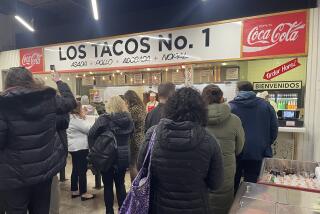Verdejo reigns in Rueda
Defying the trend of generic internationalization in the wine world, Rueda in northern Spain has come back full circle to its unique local grape.
Verdejo makes for one of the most delightful white wines of summer: aromatic and lively, with refreshing lime fruit and pretty jasmine notes. The price range is reasonable, about $9 to $20. No wonder Rueda is the only region in Spain where exports actually increased during the worldwide economic downturn of 2009.
Verdejo’s comeback is a feel-good story for people who don’t want wine everywhere to be the same. As recently as 1993, only 30% of the grapes planted in Rueda were Verdejo. Today it’s more than 80%.
“We have a flag in Rueda, and that flag is Verdejo. It’s what distinguishes us from the rest of the world,” says Ramón Bocos Ruiz, secretary of the region’s governing body, the Consejo Regulador D.O. Rueda.
Verdejo has been grown in Rueda for about 1,000 years. It’s believed to have been brought in the 11th century by Christians living under Moorish rule, though where they found it is unknown. It may be related to the Portuguese grape Verdelho — it may even be the same grape genetically — but the relationship has not been proved.
Verdejo fell out of favor in Rueda in the 1930s, as many farmers who were being paid by the ton switched to Palomino and Viura, bland grapes that produce bigger crops.
It’s no wonder, as Rueda wineries then made mostly oxidized, sherry-like wines in which the grape wasn’t crucial. Some delightful fresh wines were made from Verdejo, but only people in the know could find them, as they were sold in bulk to local bars.
Fortunately, one person who did know about them was Francisco Hurtado de Amézaga, owner of Marqués de Riscal winery in nearby Rioja. He was unsatisfied with Rioja’s white wines, made from Viura, and decided to build a winery in Rueda.
“We had to pay bigger prices for Verdejo because otherwise they would pull it all out,” said Francisco’s son Luis Hurtado de Amézaga, technical director at the Rueda winery.
However, the great French oenologist Émile Peynaud didn’t trust Verdejo. He recommended that Marqués de Riscal also urge the planting of Sauvignon Blanc.
Sauvignon Blanc has been a mixed blessing for Rueda. It has helped garner more international attention and there’s still plenty of it today; many wineries make a Verdejo and a Sauvignon Blanc. A wine labeled Rueda Verdejo must be 85% Verdejo, whereas a wine just labeled “Rueda” need only be 50% Verdejo.
But Verdejo makes the region’s best wines, as even Sauvignon Blanc winemakers will attest. A telling quote, from Bodegas Naia winemaker Eulogio Calleja: “For me, coming from Rueda, adding Sauvignon Blanc to Verdejo is like slashing my wrists.”
Yet, Amézaga says, “We sell Sauvignon Blanc for more than our Verdejo because it’s a French variety. Our distributors ask for it. I can tell you I’m not very happy with it. The aromas are not so nice when it gets hot.”
That’s not the case with Verdejo; hotter summers don’t seem to hurt the quality. Moreover, there’s less winery variation with Verdejo than Sauvignon Blanc. The difference between great ones and weak ones isn’t huge because of an unusually strict quality-testing program at the governing body. If it says “Rueda Verdejo” on the label, it’s probably at least decent.
Here are two tips for getting a great, rather than good, wine:
• Verdejo doesn’t age well. If you like the taste of old wine, some of the ‘06s and ‘07s are interesting, but I prefer the freshness of the ‘08s and ‘09s. Moreover, many wineries in the region use plastic closures, which start to fail as soon as 18 months after bottling, so if you do buy an older wine, look for a screw cap.
• Some wineries are experimenting with oak for variation, and so they can charge more. I haven’t yet tasted an oaked Verdejo that’s better than the same winery’s unoaked wine.
The best wine I tasted in Rueda on two separate visits in the last three years (I love the stuff) was made by Victoria Pariente, who named her winery after her father. He died in 1987, the year before she founded it.
The 2009 Jose Pariente Rueda Verdejo is perfectly balanced, with notes of lime, green apple skin and jasmine and nothing out of place. That’s not an accident — balance is Victoria’s obsession.
“Mathematics don’t have much of a place in this winery,” she says. “People always ask me how much time this wine spends in the tank. I can’t really answer the question. Wines are like bears. In a winter where the weather is cold, the bear will hibernate. It can spend more time. But when the weather is warm, the bear will be more active. You have to take it out sooner. The answer is you have to taste a lot of wine.”
There are also plenty of good, cheaper Verdejos. I love the 2009 Shaya Rueda Verdejo “Old Vines” for its lime fruit and jasmine that intensifies on the finish. I also like the 2008 Bodegas Naia Rueda Verdejo, which has a fuller mouth feel and some notes of anise.
The 2008 Hermanos del Villar Oro de Castilla Rueda Verdejo has more grapefruit and nectarine character, with good balance and mouth feel. And the 2008 Marqués de Riscal Rueda — not listed as Verdejo, though Amézaga told me it’s 90% Verdejo — is just $9.
A thousand years of history for $9: Now that’s good value.
food@latimes.com
More to Read
Eat your way across L.A.
Get our weekly Tasting Notes newsletter for reviews, news and more.
You may occasionally receive promotional content from the Los Angeles Times.






